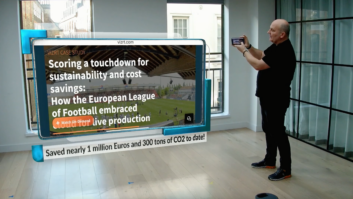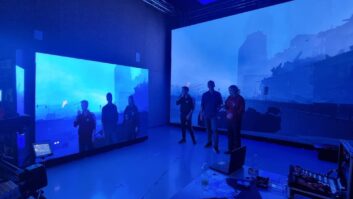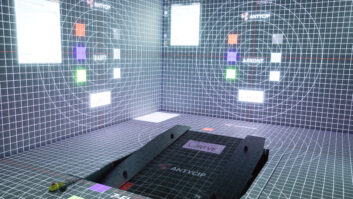In the current remote working environment, organisations face a real challenge trying to effectively upskill their workforce and keep them connected. Pandemic-induced cost constraints limit the options and as a result, businesses increasingly turn to digital technologies to overcome these issues. Our latest CEO survey revealed that a growing number of CEOs (36 per cent) are aiming to focus on productivity through technology and automation, which is more than double the share of CEOs who said the same in 2016. A lucrative option to realise this strategy is using immersive virtual and augmented reality (collectively referred to as XR or mixed reality), which have become popular tools for educating and upskilling, hence are increasingly adopted by businesses. Their large-scale deployment has only been accelerated by the emergence of affordable, untethered and increasingly lightweight head-mounted displays (HMDs) that offer high resolutions, as well as the advent of 5G which makes web-based AR activations more accessible.
In an Installation article earlier this year, our team talked about the benefits of virtual reality for remote collaboration (Charlie Neuner, page 29 March/April 2021, Installation) and how Covid-19 has acted as an accelerant to the adoption of this technology. Our VR collaboration sessions with over 500 clients and internal attendees from various industries are testament to this development. Joiners in our sessions feel spatially present and thus more connected to each other, are less distracted and enjoy the benefits of unlimited space and highly customisable environments. The merits of XR for business extend well beyond this use case, with applications for remote assistance, training and education.
Remote assistance: exchange real-time information with remote experts to reduce errors and improve performance
Experts often travel from remote locations to consult on difficult procedures; however, their time and travel is costly and more recently limited by the pandemic. Alternatively, specialists on the job can use hands-free AR devices to confer with remote experts in real time and superimpose information onto their real-world environment to guide them.
Hands-free AR devices include the Microsoft HoloLens 2, which allowed a surgeon in Brazil to conduct a complicated shoulder arthroscopy, with professors from France and the US tuning in to confer on each step and share their respective approaches. As computers or phones could not be taken into the sterile operating room, the HoloLens enabled surgeons to view critical 3D holographic images of the patient’s anatomy and rotate them in the air through hand-tracking. Elsewhere, the Realwear HMT-1Z1, which is PPE compatible, was used by a UK wind turbine company to rapidly upskill their workforce. Their work occurs at over 100 metres in height, where workers cannot use their hands to navigate through crucial maintenance information. The headset allowed them to view information in their field of view and control what they saw entirely through voice commands.
Remote assistance through AR has proven to be highly effective for improving performance and is a powerful tool for educating workforces on practical skills, saving time and reducing errors. While remote assist primarily targets the logistics and maintenance industry, VR can also be a force for good in teaching a range of job skills and soft skills in other business sectors.
- The annual Installation Pro AV Outlook report is now available
- Exclusive: Why XR stage technology is here to stay
- Register for the Installation-PSNI Transform the Hybrid Workplace virtual conference
VR for job simulation and soft skills training: interact and practice with virtual humans in realistic, safe environments
Recent years have seen a rise in ‘off-the-shelf’ VR packages: education-focused modules that are redeployable and scalable across learners and organisations. Their fixed content takes the user through a learning journey, often with supplementary material like comprehension tests and practice sessions; all the user has to do is press ‘play’. VR and AR are already well-established tools for teaching hard skills in this fashion, such as flight simulator experiences for training pilots or surgery simulations for junior doctors.
VR modules are now also becoming a powerful tool for teaching a range of soft skills. Learners are immersed in realistic settings where they can practice relevant skills with virtual humans, including how to display leadership in challenging situations or navigate difficult conversations. These skills are particularly needed in the current pandemic, but cannot be taught in-person. Even as we return to hybrid working, organisations will continue seeking alternative learning delivery methods that are cost-effective, time-saving and environmentally sustainable. While e-learning modules might satisfy these points, they often leave learners fatigued and distracted, resulting in poor learning outcomes. VR provides a strong alternative to traditional delivery methods for both hard and soft skills training, presenting a number of key benefits:
- Fully immersive experiences: VR has the unique ability to create a sense of presence, allowing the user to experience novel environments and put themselves in the shoes of someone else
- Higher emotional connection: another benefit of the immersive features, learners are naturally more invested in the content if they experience it from a first-person narrative and are asked to actively engage in tasks
- Focused sessions, free from distractions: VR headsets come with the added benefit of dissuading learners from focusing their attention elsewhere; who would want to look at their phone if they are fully immersed in an interactive environment?
- Dangerous environments can be recreated safely: an essential benefit for hard skills training, but also crucial for cultivating soft skills. For example, practicing a speech in front of a highly realistic audience can induce nervousness and stage fright, which users can then overcome
- Natural interactions: VR learners do not feel as observed as they might do during classroom training, hence feel less forced to provide answers that they think the learning facilitator wants to hear. Responses are more honest and indeed our own client feedback on soft skills experiences has raised this as a crucial benefit
Additionally, in a study PwC conducted on the value of virtual reality for soft skills training specifically, we found the following benefits:
- Rapid upskilling: our research has shown that VR learners can learn up to four times faster in VR compared to learning in the classroom. Accounting for the time needed to teach learners how to use the VR headset, they still complete training three times faster than classroom learners, while travel time is also negated through VR training
- Increased confidence: learners in our soft skills study have reported feeling 275 per cent more confident to apply their learnings after training in VR, a 40 per cent improvement over classroom and 35 per cent improvement over e-learn training. A main driver for this is that they get the opportunity for hands-on practice from a first-person perspective
- More cost effective: when deployed at scale, VR becomes more cost effective than both classroom and e-learning. Our research suggests that at 375 learners, VR achieves cost parity with classroom learning, and at 1,950 learners, it becomes more affordable than e-learning. Affordability will only increase as HMDs become more commercially available
Recent breakthroughs in conversational AI and enhanced data analytics are fuelling these experiences. They enable the learner to have more realistic interactions and examine their performance, for instance through monitoring pace and eye contact when practicing a speech.
Our use cases show how XR can be an impactful and cost-effective enabler for businesses, and while we don’t see it wholly replacing all established forms of education and training, some unique benefits can only be achieved through VR technology. We have covered a few pertinent examples here, but the possibilities of the technology reach much further; our recent research into commercial XR usage in industry shows that over 1,500 UK companies now actively integrate XR to their processes, with L&D [learning and development] being a major focus area. XR will continue to help businesses upskill their workforce more efficiently and cost effectively, which will only become more valuable as XR technology advances and matures.
With a background in engineering, Sam Fields joined PwC UK in September 2019, and has specialised in XR and AI. He leads the XR research team, who released a study of XR adoption by companies in the UK, alongside helping to explore potential commercial relationships with suppliers. He is currently developing and collaborating in Unity to create a VR experience for the Oculus Quest. Alongside this, in the AI team he has helped to develop and strategise an internal NLP tool and a data extraction tool. Connect with him on LinkedIn or by emailing [email protected].
Yanna Zhu has joined PwC’s XR strategy team from a background in cognitive science. She helps clients globally and across a variety of industries understand the enterprise value of virtual and augmented reality. She advises businesses on use cases and technology strategy, supporting organisations to discover, design, pilot and implement immersive solutions. Alongside working on a Unity project, she has most recently helped clients and internal teams run a range of VR collaboration sessions, connecting attendees globally. She works across PwC’s wider emerging technology team with experience in disruption, smart products and AI. Connect with her on LinkedIn or by emailing [email protected].







